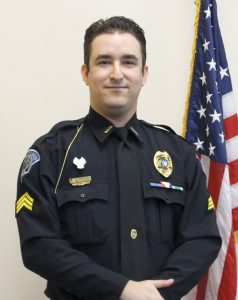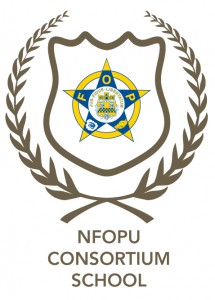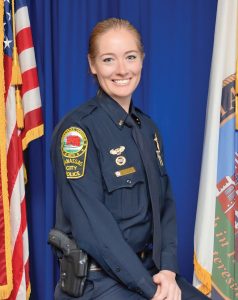
Forensic science is the application of scientific methods to legal matters. Most of us are familiar with TV shows portraying forensic scientists collecting, examining and analyzing physical evidence in criminal investigations, such as blood spatter, fingerprints and hair samples — an area known as criminalistics. However, that image doesn’t encompass the full extent and complexity of the field. Forensic science is used on both sides of criminal cases, as well as to resolve civil disputes and protect public health. Its many areas of interest include anthropology (skeletal remains), digital (photos, video and audio recordings), engineering (accidents and product failures), dentistry (tooth and bite mark identification), pathology (medical cause of death), questioned documents (handwriting and writing tools) and toxicology (effects of drugs and chemicals on the body).
“There are so many aspects of forensics, from the lab to police scenes, and it’s challenging no matter which field you choose to specialize in,” says Manassas Police Department Lieutenant Tara Petty, member of Virginia Lodge #43, who earned a master’s degree in forensics from George Mason University in 2014.
Forensic science undergraduate and graduate studies are as varied as the field itself. While the more specialized disciplines may require degrees in science or medicine, other programs are designed with working law enforcement officers in mind, sometimes as concentrations within a criminal justice major.
Maitland Police Department Sergeant T. Stitt, president of Florida Lodge #155, says that pursuing his master’s in criminal justice with a concentration in crime analysis at Tiffin University has already had a positive effect in his daily duties: “The job is partially about self-confidence and being backed up with facts. It translates when dealing with the public and how I approach the command staff with new ideas and applications. It adds credibility to my ideas.”
“It adds to your résumé when testifying in court,” Petty concurs. “I think there’s more value to my testimony now.”
Whether you’re looking for a new career path, want to boost your promotion potential by adding an advanced degree to your credentials, or just want to better understand the technical side of criminal investigations, there’s a forensics program to meet your needs.

Sergeant T. Stitt, Tiffin M.S. Crime Analysis student
Degree: Master of Science in Criminal Justice, Crime Analysis Concentration
Course sampling: Statistical Applications in Criminal Justice, Computer Applications in Crime Analysis, Geographic Information Systems: Applications in Criminal Justice
Key components: As an online program, the course schedule is asynchronous, meaning students determine how to manage studies in conjunction with ongoing professional and personal commitments
Faculty insight: “Detectives or patrol officers who want a graduate degree in crime analysis can apply that information to the day-to-day job. By getting this degree, [officers] become more valuable to their agencies to figure out how to better use resources.” — Lacy K. Ellis, Ph.D., assistant professor and graduate department chair, Criminal Justice & Security Studies
 FOP member POV: “My favorite class so far is Theories of Crime Analysis, which is the first class. The emphasis is on why crime happens, the opportunities for criminals and the psychological influence. You see things the way criminals see them, with the stats that support it.” — Florida Lodge #155 president Sergeant T. Stitt, Maitland Police Department, current student
FOP member POV: “My favorite class so far is Theories of Crime Analysis, which is the first class. The emphasis is on why crime happens, the opportunities for criminals and the psychological influence. You see things the way criminals see them, with the stats that support it.” — Florida Lodge #155 president Sergeant T. Stitt, Maitland Police Department, current student
Degree: Bachelor of Science in Forensic Science
Course sampling: Instrumental Analysis, Forensic DNA Analysis, Biochemistry of Macromolecules
Key components: This program is one of the oldest forensic science programs in the country, and one of 18 institutions accredited by the American Academy of Forensic Sciences. Enrollees opt into either a forensic chemistry or a forensic biology track.
Faculty insight: “Our program is very applied. We’re focusing on critical thinking and problem-solving skills that can be applied to a suite of applications, including investigations. We also make sure our students are aware of ethical, legal and regulatory issues in forensic science.” — Lori J. Wilson, Ph.D., professor of chemistry and Forensic Science Program director

Lieutenant Tara Petty, George Mason M.S. Forensic Science graduate
Degree: Forensic Science Graduate Certificate and Master of Science in Forensic Science
Course sampling: Law and Forensic Science, Issues in Forensic Anthropology, Forensic Chemistry
Key components: In addition to 18 credits in forensics classes, students complete a forensics capstone course. As a member of an interdisciplinary team, they assess and evaluate a real-world crime scene, utilizing scientific, quantitative and legal analysis skills.
Faculty insight: “One of the nice things about the certificate is that it’s a minimal commitment. Within a year and a half, you have a graduate certificate in forensic science, and typically that can lead on to a master’s degree, which is a total of 36 credits.” — Emily Rancourt, Forensic Science Program professor and assistant director
FOP member POV: “The school brought in staff who have been on the law enforcement side, but also on the scientific side. It’s a nice mixture. There are practical experiences for those who have worked crime scenes, and it’s nice to see they have some of the same thoughts and training as I do.” — Virginia Lodge #43 member Lieutenant Tara Petty, City of Manassas Police Department, 2014 M.S. graduate
Degree: Bachelor of Science in Forensic Science
Course sampling: Forensic Microscopy, Trace Evidence, Genetics Laboratory
Key components: Graduates will absorb the core competencies required to practice as a professional forensic scientist. Their education includes preparation to testify in court proceedings.
Faculty insight: “Students who want to be a law enforcement officer choose this degree because they feel it gives them a deeper understanding of what happens once the evidence is off of the scene and into the lab for analysis.” — Tamra Legron-Rodriguez, Ph.D., lecturer and Forensic Science undergraduate coordinator
Degree: Master of Science in Criminalistics
Course sampling: Crime Mapping and Analysis, Interviewing and Dispute Resolution, Physical and Pattern Evidence
Key components: Rolling admission allows students to start at their convenience, and online classes work around other commitments. The program concludes with a week-long capstone project that enables students to utilize the state-of-the-art Forensic Investigation Center on campus.
Faculty insight: “Our goal is to give them hands-on experiences. How can you have hands-on experience online? We use a third-party vendor that sends lab kits to students at their homes. Students work on the kits, doing the experiments at home, and write up reports.” — Jerry Clark, Ph.D., retired FBI special agent, assistant professor
 Degree: Master of Science in Crime Scene Investigation
Degree: Master of Science in Crime Scene Investigation
Course sampling: Bloodstain Pattern Analysis I, Firearms and Toolmark Identification, Digital Image Processing
Key components: This graduate degree is designed as a hybrid program that combines traditional on-campus and online classes. Applicants must hold a bachelor’s degree from an accredited university and have passed at least one semester each of chemistry and biology.
 Faculty insight: “I tell students that when they finish this program, we can drop them at a homicide scene and they can properly process the scene, including diagramming it, note taking and photography to casting shoeprints, processing fingerprints and analyzing blood splatter.” — Edward Robinson, associate professor, Forensic Science Department
Faculty insight: “I tell students that when they finish this program, we can drop them at a homicide scene and they can properly process the scene, including diagramming it, note taking and photography to casting shoeprints, processing fingerprints and analyzing blood splatter.” — Edward Robinson, associate professor, Forensic Science Department

Degree: Bachelor of Arts in Criminal Justice, Forensics
Course sampling: Forensic Studies, Forensic Documentation, Applied Criminology
Key components: In addition to incorporating specific forensic instruction, faculty structured the curriculum to address communication, ethics and problem-solving skills.
Faculty insight: “We have speakers who represent the coroner or patrol officers and they discuss how they feel about evidence preservation or investigation procedures — what happens at the beginning, during, after and at the prosecution stage of a case.” — Karin J. Storm, Ed.D., assistant professor of criminal justice and Social Science Curriculum Team vice chair

Degree: Bachelor of Science in Forensic Science
Course sampling: Research Methods in Justice Studies, Criminological Theory, Seminar in Justice Studies
Key components: Students have the option to take one or more tracks, including crime scene investigation, behavioral crime, forensic accounting, computer forensics and forensic anthropology, as well as general forensic science.
Faculty insight: “Law enforcement needs a solid foundation for not only the legal, but also the technical piece. Think about how many cellphone models there are. Each has a different criteria or new apps and some have encryptions. Our students are learning how to guard the integrity of that digital evidence.” — Raymond Hsieh, Ph.D., professor of Cyber Security, Forensics and Justice, and director of Justice Studies, Department of Criminal Justice
 Degree: Certificate in Medicolegal Death Investigation (undergraduate)
Degree: Certificate in Medicolegal Death Investigation (undergraduate)
Course sampling: Medicolegal Death Investigation I & II, Medicolegal Death Investigation for Emergency Responders, Forensic Photography
Key components: This certificate program was created in collaboration with the New York State Division of Homeland Security and Emergency Services and is open to individuals with or without an undergraduate degree. Courses are designed to expose students to different training scenarios and guidance on interaction with various practitioners.
Faculty insight: “At a death scene, patrol officers are there. Crime scene people are there. How do we all interact? The goal, in my opinion, is communication, cooperation, coordination and anticipation. We work together for a legally defensible investigation.” — Brian Ehret, F-ABMCI, senior forensic investigator, Onondaga County Medical Examiner’s Office, Center for Forensic Sciences, adjunct professor
 Degree: Forensic Sciences Graduate Certificate
Degree: Forensic Sciences Graduate Certificate
Course sampling: Skeletal Biology, Spectrometric Identification of Organic Compounds, Morphometric Analysis
Key components: This program promotes an interdisciplinary understanding of the forensic sciences. Additionally, participants attend seminars and conferences through which they can expand their professional networks.
Faculty insight: “We also bring in guest speakers who are either doing cutting-edge research or have casework experience, or work for a division of public safety. That’s applied with a research-and-development side to get a big picture of job opportunities and preparation beyond the certificate.” — Stacy Lindshield, Ph.D., lecturer and program coordinator
For further insights from the FOP members profiled in this article, check out “Member Interview: Higher Education in Forensic Science.”
Read this story in the Spring 2017 issue of FOP Journal.




